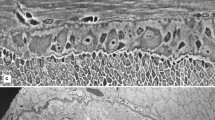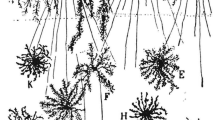Summary
The basic principle of “flexible stability” is evident in the construction of the fibrous capsule of the nervous system of Lumbricus terrestris L. The astrocyte-like glial cells are attached by means of different types of half-desmosomes to this fibrous tissue. On the other hand the glial elements form basket-like structures on the surface of nerve cell bodies and surround the dorsal giant axons in the form of lamellae. Specialized zonulae adhaerentes of glial processes are very abundant in those areas that are mainly subject to deformation. These results, and other indications of the existence of a specific pattern of distribution of glial cell junctions, support the hypothesis of a stabilizing function of the contact zones within the ventral nerve cord. Neither maculae adhaerentes nor zonulae occludentes and septate desmosomes are found in the nervous system of Lumbricus; the functional consequences are discussed.
Zusammenfassung
Das Grundgerüst des Nervensystems von Lumbricus terrestris L. wird von dem aus verformbaren Bogensystemen aufgebauten Neurilemmschlauch gebildet. Astrozytenähnliche Gliazellen sind durch Kontaktzonen mit den Neurilemmsepten verknüpft. Die gliösen Elemente umhüllen faserkorbartig die Ganglienzellen, scheiden — zu Lamellen angeordnet — die dorsalen Riesenaxone ein und unterteilen das zentrale Neuropil. Auf diese Weise werden die nervösen Strukturen nach dem Prinzip der flexiblen Stabilisierung geschützt. Die verschiedenartigen Zonulae adhaerentes und Hemidesmosomen verhindern gemeinsam mit dem Faserbügelsystem des Neurilemms sowie den Gliafilamenten eine unphysiologische Deformierung des Bauchmarks. Die charakteristische Verteilung der Zonulaketten im Bereich der dorsalen Riesenaxone sowie auch in den Durchdringungszonen mehrerer aneinandergrenzender Gliafaserkörbe der Ganglienzellschicht deutet auf einen stabilisierenden Effekt der Kontaktzonen hin. Das Fehlen von Maculae adhaerentes, Zonulae occludentes und septierten Desmosomen wird mit Hinweis auf die daraus resultierenden funktionellen Konsequenzen diskutiert.
Similar content being viewed by others
Literatur
Anderson, W. A., A. Weissman, and R. A. Ellis: A comparative study of microtubules in some vertebrate and invertebrate cells. Z. Zellforsch. 71, 1–13 (1966).
Baccetti, B.: Collagen of the earthworms. J. Cell Biol. 34, 885–891 (1967).
Barr, L., M. M. Dewey, and W. Berger: Propagation of action potentials and the structures of the nexus in cardiac muscle. J. gen. Physiol. 48, 797 (1965).
Behnke, O., and T. Zelander: Filamentous substructure of microtubules of the marginal bundle of mammalian blood platelets. J. Ultrastruct. Res. 19, 147–165 (1967).
Brightman, M. W., and S. L. Palay: The fine structure of ependyma in the brain of the rat. J. Cell Biol. 19, 415–439 (1963).
Cajal, S. R.: Neuroglia y neurofibrillas del Lumbricus. Trab. Lab. Inv. Biol. Madr. 3, 277–285 (1904).
Dewey, M. M., and L. Barr: A study of the structure and distribution of the nexus. J. Cell Biol. 23, 553–585 (1964).
Evans, E. M.: On the ultrastructure of the synaptic region of visual receptors in certain vertebrates. Z. Zellforsch. 71, 499–516 (1966).
Fahrenbach, W. H.: The morphology of some simple photoreceptors. Z. Zellforsch. 66, 233–254 (1965).
Farquhar, M. G., and G. E. Palade: Junctional complexes in various epithelia. J. Cell Biol. 17, 375–412 (1963).
—: Cell junctions in amphibian skin. J. Cell Biol. 26, 263–291 (1965).
—: Adenosin triphosphatase localization in amphibian epidermis. J. Cell Biol. 30, 359–379 (1966).
Fawcett, D. W.: Structural specialization of the cell surface. In: Frontiers in cytology (ed. S. L. Palay), p. 19. New Haven: Yale University Press 1958.
Hama, K.: Some observations on the fine structure of the giant nerve fibers of the earthworm, Eisenia foetida. J. biophys. biochem. Cytol. 6, 61–66 (1959).
—: The fine structure of some blood vessels in the earthworm, Eisenia foetida. J. biophys. biochem. Cytol. 7, 717–724 (1960).
Harkin, J. C.: A series of desmosomal attachments in the Schwann sheath of myelinated mammalian nerves. Z. Zellforsch. 64, 189–195 (1965).
Havet, J.: Contribution à l'étude de la névroglie des invertébrés. Trab. Lab. Inv. Biol. Madr. 14, 35–85 (1916).
Held, H.: Zur weiteren Kenntnis der marginalen Neuroglia. Verh. Ges. dtsch. Naturf. Ärzte, 79. Verslg., 2. Teil, S. 463–465, Dresden 1907.
—: Über die Neuroglia marginalis der menschlichen Großhirnrinde. Mschr. Psychiat. 26, 360–416 (1909).
Heuser, J. E., and C. F. Doggenweiler: The fine structural organization of nerve fibres, sheaths, and glial cells in the prawn, Palaemonetes vulgaris. J. Cell Biol. 30, 381–403 (1966).
Keech, M. K.: Electron microscope study of the normal rat aorta. J. biophys. biochem. Cytol. 7, 533–538 (1960).
Kelly, D. E.: Fine structure of desmosomes, hemidesmosomes and an adepidermal globular layer in developing newt epidermis. J. Cell Biol. 28, 51–72 (1966).
Kükenthal. W., u. E. Matthes: Leitfaden für das zoologische Praktikum, S. 194–206. Stuttgart: Gustav Fischer 1960.
Landolt, A. M.: Elektronenmikroskopische Untersuchungen an der Perikaryenschicht der Corpora pedunculata der Waldameise (Formica lugubris Zett.) Mit besonderer Berücksichtigung der Neuron-Glia-Beziehung. Z. Zellforsch. 66, 701–736 (1965).
Loewenstein, W. R., and Y. Kanno: Studies on an epithelial (gland) cell junction. I. Modifications of surface membrane permeability. J. Cell Biol. 22, 565–586 (1964).
Niessing, K.: Über systemartige Zusammenhänge der Neuroglia im Großhirn und ihre funktionelle Bedeutung. Gegenbauers morph. Jb. 78, 537–584 (1936a).
—: Gliastrukturen der Großhirnrinde. Anat. Anz. 81, 212–215 (1936b).
Pearse, A. E. G.: Histochemistry, 2nd. ed., p. 819. London: Churchill 1960.
Robertis, de, E. D. P., and H. S. Bennett: Some features of the submicroscopic morphology of synapses in frog and earthworm. J. biophys. biochem. Cytol. 1, 47–58 (1955).
Romeis, B.: Mikroskopische Technik. München: Leibniz 1948.
Rosenbluth, J., and S. L. Palay: The fine structure of nerve cell bodies and their myelin sheaths in the eighth nerve ganglion of the goldfish. J. biophys. biochem. Cytol. 9, 853–877 (1961).
Schaffer, J.: Das Epithelgewebe. In: Handbuch der mikroskopischen Anatomie des Menschen (Hrsg. W. Möllendorff), Bd. II/1, S. 1–231. Berlin: Springer 1927.
Scharrer, E.: The capillary bed of the central nervous system of certain invertebrates. Biol. Bull. 87, 52–58 (1948).
Sedar, A. W., and J. R. Forte: Effects of calcium depletion on the junctional complex between oxyntic cells of gastric glands. J. Cell Biol. 22, 173–188 (1964).
Staubesand, J., u. K.-H. Kersting: Feinbau und Organisation der Muskelzellen des Regenwurms. Z. Zellforsch. 62, 416–442 (1964).
—, B. Kuhlo u. K.-H. Kersting: Licht- und elektronenmikroskopische Studien am Nervensystem des Regenwurms. I. Mitteilung. Die Hüllen des Bauchmarks. Z. Zellforsch. 61, 401–433 (1963).
Steinberg, M.: The problem of adhesive selectivity in cellular interactions. In: Cellular membranes in development. 22nd Symposium of the Society for the Study of Development and Growth (ed. M. Locke), p. 321–366. New York: Academic Press 1964.
Sterba, G., u. G. Hoheisel: Darstellung des neurosekretorischen Systems der Insekten mit Pseudoisocyanin. Z. mikr.-anat. Forsch. 72, 31–48 (1964).
Studnička, F. K.: Die Organisation der lebendigen Masse. In: Handbuch der mikroskopischen Anatomie des Menschen (Hrsg. W. Möllendorff), Bd. I/1, S. 421–568. Berlin: Springer 1927.
Ussing, H. H., and E. E. Windhager: Nature of the shunt path and active sodium transport path through frog skin epithelium. Acta physiol. scand. 61, 484 (1964).
Vogel, A.: Zelloberfläche und Zellverbindungen im elektronenmikroskopischen Bild. Verh. dtsch. Ges. Path. 43, 284–295 (1958).
—: Zellgrenzstrukturen im elektronenmikroskopischen Bild. Ther. Ber. 31, 67–71 (1959).
Wiener, J., D. Spiro, and W. R. Loewenstein: Studies on an epithelial (gland) cell junction. II. Surface structure. J. Cell Biol. 22, 587–598 (1964).
Wood, R. L.: Intercellular attachment in the epithelium of hydra as revealed by electron microscopy. J. biophys. biochem. Cytol. 6, 343–351 (1959).
Zimmermann, P.: Fluoreszenzmikroskopische Studien über die Verteilung und Regeneration der Faserglia bei Lumbricus terrestris L. Z. Zellforsch. 81, 190–220 (1967a).
—: Methodische Modifikationen und eine neue Technik zur Darstellung des neurosekretorischen Apparates und der Neuroglia bei Wirbellosen (Lumbricus terrestris L.) Z. wiss. Mikr. 68, 154–162 (1967b).
Author information
Authors and Affiliations
Additional information
Teil einer medizinischen Doktorarbeit.
Mit Unterstützung durch die Deutsche Forschungsgemeinschaft.
Rights and permissions
About this article
Cite this article
Zimmermann, P. Struktur, Verteilung und Funktion der Kontaktzonen im Bauchmark von Lumbricus terrestris L.. Z. Zellforsch. 87, 137–158 (1968). https://doi.org/10.1007/BF00326566
Received:
Issue Date:
DOI: https://doi.org/10.1007/BF00326566




